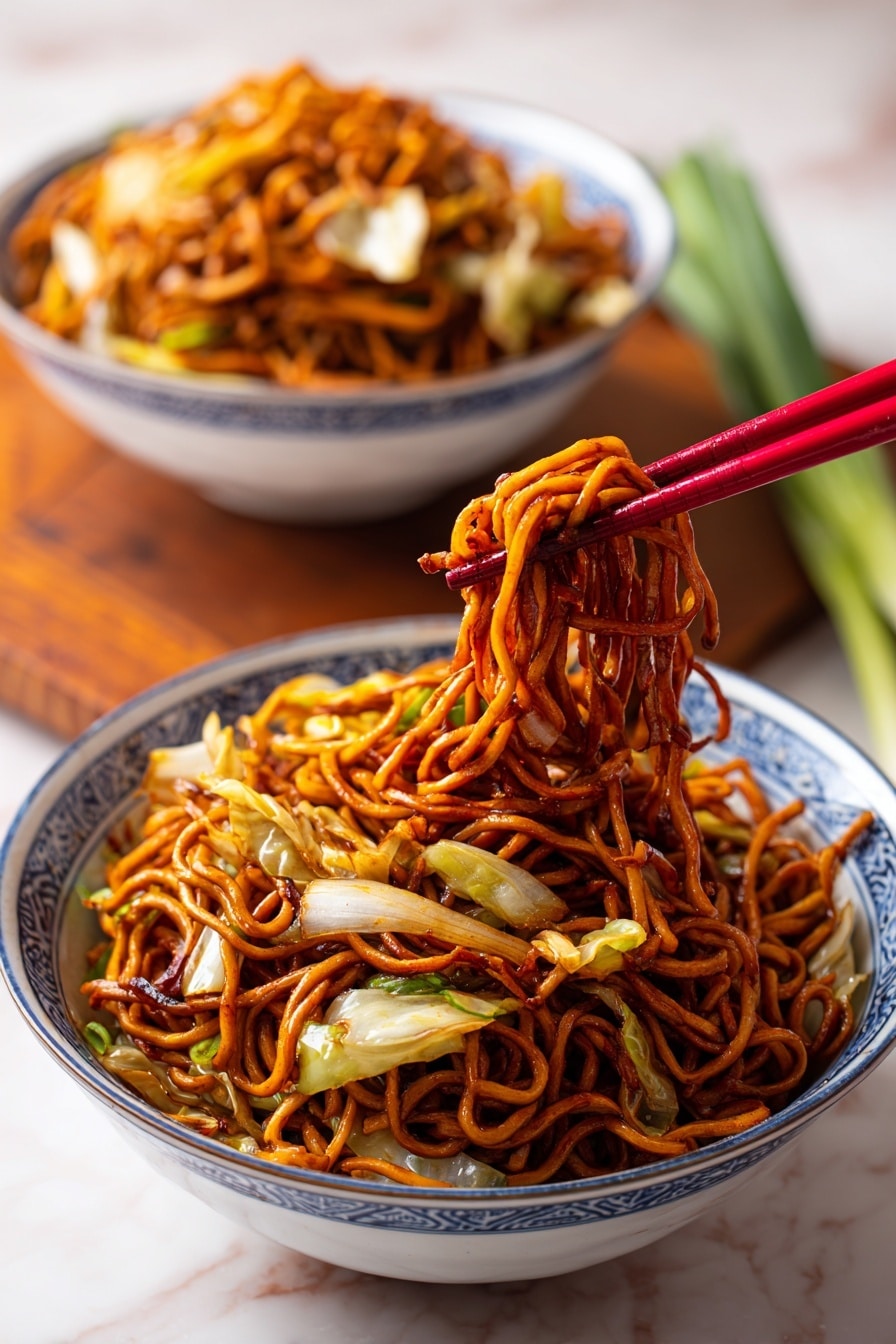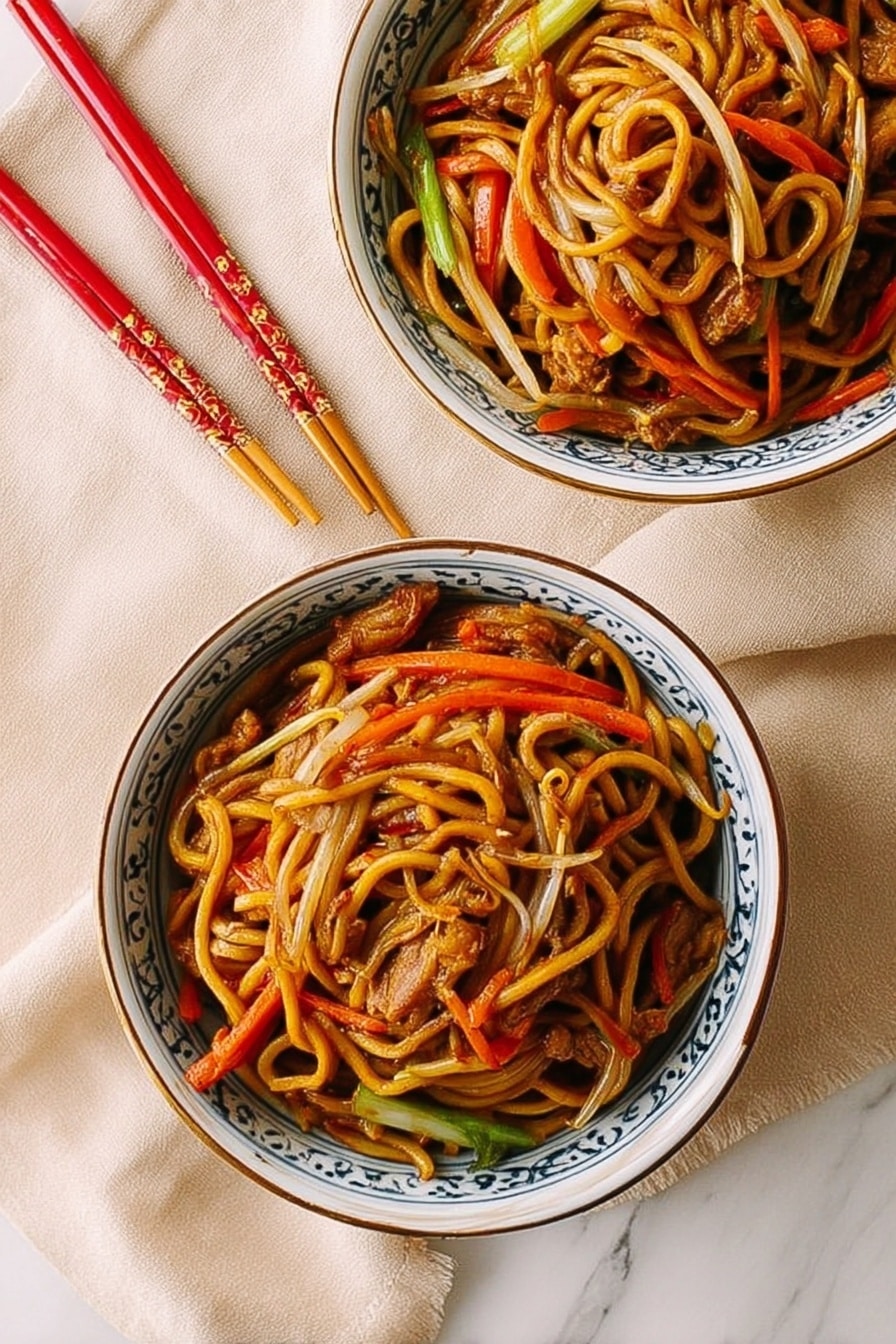If you’ve ever craved that deliciously saucy and perfectly textured noodle dish at your favorite Chinese spot, you’re in for a treat. This Restaurant-Style Chicken Lo Mein Recipe brings all that takeout goodness right into your kitchen — and trust me, it’s way easier than you think! I absolutely love how this turns out every single time, with tender chicken, crisp veggies, and noodles that soak up that savory sauce just right. Whether you’re cooking for your family or just craving a cozy dinner, this recipe will quickly become a staple you’ll want to make again and again.
Why You’ll Love This Recipe
- Quick and Easy: You’ll get a restaurant-quality meal on the table in just about 30 minutes.
- Flavor-Packed Sauce: The blend of light and dark soy, oyster sauce, and sesame oil creates authentic depth you’ll crave.
- Customizable Veggies: You can swap or add whatever fresh veggies you have on hand for your perfect bowl.
- Better Than Takeout: Once you make this, you might just skip ordering lo mein forever.
Ingredients You’ll Need
All the ingredients in this Restaurant-Style Chicken Lo Mein Recipe work together to create that irresistible harmony of textures and flavors we all love. When you shop, look for fresh lo mein egg noodles if you can, and don’t worry if you find only dried or fresh pre-cooked — I’ll walk you through how to handle each. Also, quality soy sauce and oyster sauce make a big difference in elevating the taste.
- Lo Mein Egg Noodles: Fresh is best for that authentic bite, but dried works if cooked carefully.
- Chicken Thighs (or Breast): Thighs stay tender and juicy; breast works if you prefer leaner meat.
- Cornstarch: Helps give the chicken a nice velvety texture when combined with the marinade.
- Oyster Sauce: Adds that signature umami punch – don’t skip it!
- Light and Dark Soy Sauce: Light soy sauce keeps it salty and bright; dark soy adds rich color and subtle sweetness.
- Sesame Oil: Just a little for that lovely nutty aroma.
- Garlic: Fresh minced garlic wakes up the whole dish.
- Cabbage, Carrots, Bean Sprouts, and Scallions: A mix of crunchy veggies for color, texture, and freshness.
- Shaoxing Wine: A classic Chinese cooking wine that adds complexity (you can substitute dry sherry if needed).
- Salt, Sugar, White Pepper: For seasoning balance in the sauce.
- Oil: For stir-frying – neutral oil like vegetable or canola works best.
Variations
One thing I love about this Restaurant-Style Chicken Lo Mein Recipe is how flexible it is. Over time, I’ve swapped ingredients depending on what’s in my fridge or my family’s preferences. Feel free to customize this recipe to suit your taste or dietary needs.
- Vegetarian Version: Replace chicken with firm tofu or extra mushrooms — my veggie-loving friends go crazy for this swap.
- Spicy Kick: Add a dash of chili oil or some fresh chopped chilies if you want that fiery restaurant-style heat.
- Alternative Noodles: Use rice noodles or even whole wheat noodles for a different texture and flavor.
- Seasonal Veggies: Swap in bell peppers, snap peas, or broccoli for more color and crunch — I always encourage experimenting!
How to Make Restaurant-Style Chicken Lo Mein Recipe
Step 1: Prep Your Noodles and Chicken for Success
Start by figuring out your noodles — fresh lo mein egg noodles are usually pre-cooked and just need to come to room temperature, while dried noodles require boiling until just tender. I used to overcook mine, and the noodles got mushy really fast, so trust me, timing here is everything. Meanwhile, toss your chicken strips in cornstarch, water, a little oil, and oyster sauce. This combo gives you that tender, silky coating on the chicken that soaks up flavors beautifully.
Step 2: Make the Perfect Sauce
In a bowl, dissolve salt and sugar in hot water, then stir in light and dark soy sauces, sesame oil, and white pepper. This sauce is where those takeout vibes come alive — balanced salty, sweet, and umami notes combined with a little warmth from the pepper. It’s a simple mix that packs a punch and ties everything together.
Step 3: Stir-Fry Like a Pro
Heat your wok or large skillet over high heat with some oil and sear the chicken until it’s lightly browned but still juicy inside. Remove it and set aside. Then add more oil, toss in your garlic for just 10 seconds so it’s fragrant but not burnt, followed quickly by cabbage and carrots. I learned that stirring these on high heat and adding Shaoxing wine around the wok’s edge adds a real subtle depth of flavor — trust me, don’t skip.
Next, back in go the noodles and chicken, then drizzle on your sauce mixture. Toss everything from the bottom up so the sauce coats every strand of noodle. Cover the wok to let the noodles steam in the sauce for a minute, then stir-fry again. If the noodles seem dry, splash in a little water or stock — it keeps them slippery and perfect. Finally, throw in the bean sprouts and scallions, stir for just a minute, and it’s ready to serve.
Pro Tips for Making Restaurant-Style Chicken Lo Mein Recipe
- Don’t Overcook Noodles: I’ve learned that keeping noodles al dente before stir-frying prevents them from getting mushy later.
- Marinate the Chicken Briefly: Even a quick 10-minute marinade in cornstarch and oyster sauce helps tenderize and infuse flavor.
- High Heat is Key: Cooking on high heat keeps everything crisp and prevents sogginess, just like in your favorite restaurants.
- Add Liquid as Needed: I avoid dry noodles by adding small amounts of water or stock to loosen the sauce — it works every time.
How to Serve Restaurant-Style Chicken Lo Mein Recipe

Garnishes
I like to sprinkle extra julienned scallions right on top for that fresh bite and pop of green, plus a few toasted sesame seeds if I have them handy. Sometimes I add a little drizzle of chili oil or sriracha on the side for anyone craving some heat — it definitely wakes up the dish!
Side Dishes
To round out the meal, my go-to sides include simple steamed dumplings or hot and sour soup. Sometimes I throw together a quick Asian-inspired cucumber salad with rice vinegar and sesame seeds — it’s cool, crisp, and refreshing next to the warm lo mein.
Creative Ways to Present
I’ve even served this in pretty individual bowls for casual dinner parties, topping each serving with a soft-boiled egg and some sliced chili peppers for extra flair. Plus, it’s colorful and visually inviting, especially if you pile on the veggies in varying colors.
Make Ahead and Storage
Storing Leftovers
When storing leftovers, I find that letting the lo mein cool completely before sealing it tight in an airtight container helps keep it fresher longer. It stays great in the fridge for up to 3 days — just be sure not to leave it out at room temp for too long.
Freezing
Freezing this dish is possible but does slightly affect the noodle texture. If you want to freeze, portion into freezer-safe containers and thaw overnight in the fridge before reheating. I usually prefer eating it fresh or refrigerated, but it’s a handy option for busy weeks.
Reheating
Reheat in a hot skillet or wok with a splash of water or stock to loosen things up and prevent drying out. Microwave works too, but the skillet method keeps the noodles slippery and flavorful, almost like fresh-cooked again.
FAQs
-
Can I use chicken breast instead of thighs for this lo mein?
Absolutely! Chicken breast works fine, just slice it thinly and watch the cooking time closely as it can dry out faster than thighs. Marinating with cornstarch and oyster sauce helps keep it tender.
-
What if I can’t find fresh lo mein noodles?
No problem! You can use dried lo mein egg noodles or even spaghetti in a pinch. Just be sure to cook them until al dente, drain, and toss with a little oil to prevent sticking before stir-frying.
-
How do I avoid soggy vegetables in my lo mein?
Stir-fry veggies on high heat for a short time so they stay crisp-tender. Avoid overcrowding the pan, and add watery veggies like cabbage at the right moment to prevent releasing too much moisture.
-
Can I make this recipe vegetarian?
Yes! Swap out chicken for tofu or mushrooms, and substitute oyster sauce with vegetarian mushroom sauce or more soy sauce. The method stays the same, and it turns out delicious.
-
Is Shaoxing wine necessary in this recipe?
While Shaoxing wine adds authentic flavor, you can substitute it with dry sherry or skip it if you prefer. It gives a subtle depth, but the taste is still great without it.
Final Thoughts
This Restaurant-Style Chicken Lo Mein Recipe has become one of those comforting meals I reach for when I want something fast, satisfying, and truly flavorful. The first time I made it at home, I couldn’t believe how close it tasted to my favorite takeout spot — even better because I knew exactly what went in. Once you make this, I bet you’ll find yourself cooking it weekly, tweaking it your way, and sharing it with everyone you love. So grab those noodles and chicken, and let’s bring restaurant magic into your kitchen tonight!
Print
Restaurant-Style Chicken Lo Mein Recipe
- Prep Time: 20 minutes
- Cook Time: 10 minutes
- Total Time: 30 minutes
- Yield: 6 servings 1x
- Category: Main Course
- Method: Stovetop
- Cuisine: Chinese
Description
This Restaurant-Style Chicken Lo Mein recipe is a flavorful and easy stir-fry dish featuring tender chicken strips, fresh lo mein noodles, crisp vegetables, and a savory soy-based sauce. Perfectly balanced with hints of sesame and Shaoxing wine, this homemade version rivals any takeout favorite with delicious results in just 30 minutes.
Ingredients
Noodles and Chicken
- 1 pound fresh lo mein egg noodles
- 8 oz. boneless skinless chicken thighs or chicken breast, cut into thin strips
- 2 teaspoons cornstarch
- 2 teaspoons water
- 2 teaspoons oil, plus more for cooking
- 1 teaspoon oyster sauce
Sauce
- 2 tablespoons hot water
- 1/8 teaspoon salt
- 1/8 teaspoon sugar
- 1 tablespoon light soy sauce
- 4 teaspoons dark soy sauce
- 1 teaspoon sesame oil
- 1/8 teaspoon white pepper
Vegetables and Aromatics
- 1 clove garlic, minced
- 4 cups shredded cabbage
- 2 medium carrots, julienned (about 1 1/2 cups)
- 1 tablespoon Shaoxing wine
- 2 cups mung bean sprouts
- 2 scallions, julienned
Instructions
- Prepare the Noodles: Determine whether your lo mein noodles are raw or pre-cooked. If raw, boil them according to package instructions until tender, then drain and set aside. If pre-cooked, let the noodles come up to room temperature to ensure even cooking during stir-frying.
- Marinate the Chicken: In a medium bowl, combine the chicken strips with cornstarch, water, 2 teaspoons oil, and oyster sauce. Mix well to coat the chicken evenly which will help achieve a tender and flavorful bite during cooking.
- Make the Sauce: In a separate bowl, dissolve salt and sugar in 2 tablespoons of hot water. Then add the light soy sauce, dark soy sauce, sesame oil, and white pepper. Stir to combine thoroughly and set aside for later use.
- Cook the Chicken: Heat a wok or large skillet over high heat. Add 2 tablespoons of oil and sear the marinated chicken for a couple of minutes until browned and cooked through. Remove the chicken from the wok and set aside.
- Stir-Fry Vegetables: Add a couple more tablespoons of oil to the wok. Add the minced garlic and sauté for about 10 seconds until fragrant. Then add shredded cabbage and julienned carrots. Stir-fry on high heat for about one minute. Pour Shaoxing wine around the edges of the wok and let it cook off quickly to add a subtle depth of flavor.
- Combine Noodles and Chicken: Return the cooked chicken and prepared noodles to the wok. Pour the prepared sauce over the noodles and chicken. Toss and mix well from the bottom up for about 30 seconds to evenly distribute the sauce and ingredients.
- Steam and Finish Cooking: Reduce heat to medium, cover the wok with a lid, and let the noodles steam for one minute. Remove the lid and stir-fry the noodles again. If the noodles appear dry, add up to 1/4 cup of water or broth and continue stir-frying until noodles are loose, slippery, and heated through.
- Add Final Vegetables and Serve: Stir in mung bean sprouts and julienned scallions. Continue stir-frying for one more minute to combine all flavors and retain a slight crunch in the sprouts and scallions. Serve hot immediately.
Notes
- This chicken lo mein recipe is surprisingly easy to make at home and tastes better than most Chinese takeout.
- Use fresh egg noodles for best texture, but pre-cooked noodles can also be used by warming them to room temperature.
- You can substitute chicken thighs with chicken breast if preferred.
- Adjust soy sauce quantities to taste, keeping in mind sodium levels.
- ShaoXing wine adds authentic flavor but can be omitted or replaced with dry sherry if unavailable.
Nutrition
- Serving Size: 1 serving
- Calories: 306 kcal
- Sugar: 4 g
- Sodium: 502 mg
- Fat: 5 g
- Saturated Fat: 1 g
- Unsaturated Fat: 3 g
- Trans Fat: 0 g
- Carbohydrates: 42 g
- Fiber: 3 g
- Protein: 13 g
- Cholesterol: 58 mg



